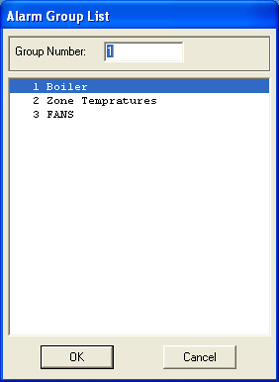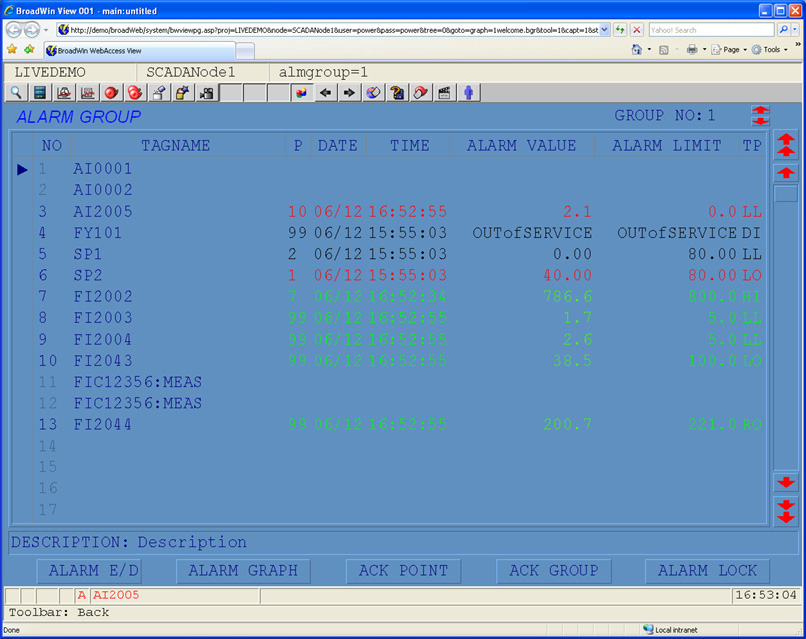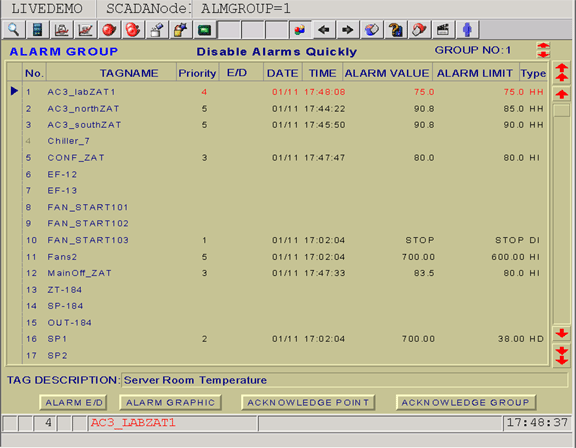
An Alarm Group is typically a process unit in a multi-process plant.
An Alarm Group Display summarizes alarm events for a fixed and limited number of tags (100 tags maximum in an Alarm Group, up to 9999 Alarm Groups). In contrast, the Alarm Summary displays all active and unacknowledged alarms in reversed chronological order.
Alarm Groups can be configured in any logical arrangement. These are user configurable.
The information provided for each tag includes the alarm priority, date and time of the alarm, alarm type, Alarm Limit, value, and status of the alarm.
The Alarm Group Displays use a pre-built template display. Alarm Groups are easily configured, by typing the Tagname in a list. Alarming does not need to be enabled to add a tag to an alarm group.
Alarm Disable/Enable pushbutton is provided on the Alarm Group. This is intended to allow a operators to Disable Alarms for a Unit that is shutdown or out of service, thereby eliminating nuisance alarms.

The Alarm Group List is a Popup Dialog
Box showing all configured Alarm Grouips.
The Alarm Group List can be viewed from the Toolbar icon
![]() or F6 function key or a
pushbutton with the <DIALOG>ALMGROUP
keymacro.
or F6 function key or a
pushbutton with the <DIALOG>ALMGROUP
keymacro.
The Alarm Group List can also be
called using the Right-Click Menu
(Right Click->Goto->Alarm Group)
and from the Point Goto Dialog Box. An alarm group can be called directly from a Pushbutton with the <GOTO>ALMGROUP=group number keymacro.
Power Users, General Users and the admin account can view Alarm Groups through a Web Browser. (Restricted users cannot view Alarm Groups through a Web Browser). All users can view Alarm Groups locally on the SCADA node using ViewDAQ.
The Alarm Group Display is a pre-built template display supplied with Web Access. It can be customized by engineers and technicians using DRAW. How your Alarm Group Colors, Flashing, Fonts, etc. behave may vary based on how (or if) the Almgrp.Bxx (and Almgrp.dxx) on your system is modified.

Red
- is an Unacknowledged Alarm
Black - is an Acknowledged Alarm
Green - is a Return To Normal that was not Acknowledged when
in Alarm (only if “Ack Alarm by Return to
Normal” is NO).
White - is a Locked Alarm, A state used for filtering and sorting
Alarms.
Pressing the Alarm Enable /Disable pushbutton will disable alarming for the selected tag (temporarily).
The alarming will be disabled until the Alarm E/D pushbutton is presses again, the .ALMED tag field is changed or the SCADA node Restarts.
To Disable or Enable Alarming for a Tag from the Alarm Group Display:
1. Select the Tagname (or anywhere on the same line)
2. Select ALARM E/D pushbutton.
Pressing the Acknowledge Screen button will acknowledge all active alarms Displayed on the screen.
If there are more than 17 alarms (i.e. the number that will fit in the Alarm Group Display at one time), only the first 17 alarms will be acknowledged. The user must use the Scroll Down (or Scroll UP) buttons to view additional Alarms, which will be unacknowledged.
Pressing the Acknowledge Tag button will acknowledge only the selected tag. To acknowledge only one tag on the Alarm Group:
1. Click on the Tagname (or anywhere on that line)
2. Click Acknowledge Tag
Pressing the Acknowledge Group pushbutton will acknowledge all active Alarms in the Alarm Group of the Selected Tag. There can be up to 100 Tags in an Alarm Group.
Indicates the Alarm Group Number. There can be an unlimited number of Alarm Groups.
Indicates the current value of the selected Tag.
Displays the description of the Selected Tag.
Lock is used to Hide All Locked alarms on the Alarm Summary. It does not hide the alarm on this Alarm Group Display. It is used to make it easier to read the Alarm Summary by removing unwanted Alarms. Alarm Lock affects only the display of alarms in Alarm Summary. Lock is a status assigned to a Tag in Alarm, by an operator, that will mark the Tag for filtering in the Alarm Summary page. An operator Locks an Alarm with the Lock Button. Then hides the Locked Alarms with the Sort: Lock. It is used for filtering only, Lock does not hold the tag in alarm or modify the behavior of alarms. Tags can also be sorted to show only Locked Alarms in the Alarm Summary List, using the Advanced Button. There will be a white rectangle prefixed to every locked alarming tag in the new default Alarm Summary display. The lock status of an alarming tag will clear automatically when the tag is not in alarm (Return to Normal) and Acknowledged. Lock will also clear if in a new alarm status (i.e. change from High Alarm to a High-High Alarm). A button labeled Lock is added to the alarm summary that allows user to select an alarm and then lock it. A checkbox labeled Lock is also added to the Alarm Summary to hide Locked Alarms first. Two checkboxes labeled Locked and Unlocked are added to the Alarm Filter Dialog Box to hide Locked or to hide Unlocked alarms from the Alarm summary. There will be a white rectangle prefixed to every locked alarming tag. See also the tag fields .ALMLK and .ALMEST and 7.5 Alarm Summary.
The Alarm Summary is a pre-built template display supplied with Web Access. It can be customized by engineers and technicians using DRAW. How your Alarm Summary Colors, Flashing, Fonts, behave may vary based on how (or if) the Almgrp.Bxx (and Almgrp.dxx) on your system is modified. This one display is used for all alarm groups. It is a template display.

Figure 7.7.1 - Customized Alarm Group. Users can modify the display in DRAW.